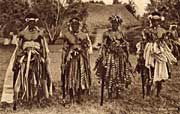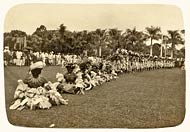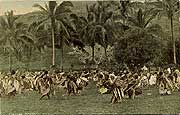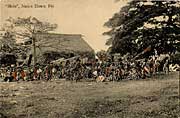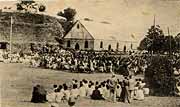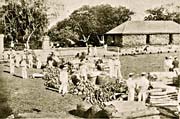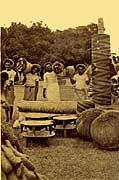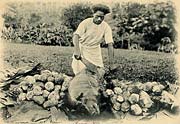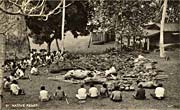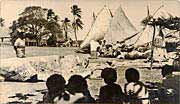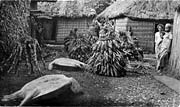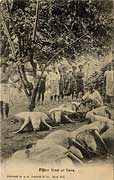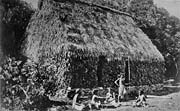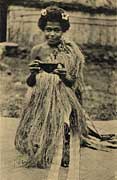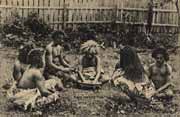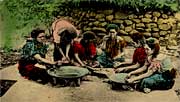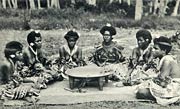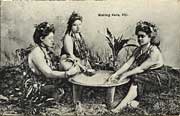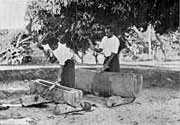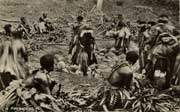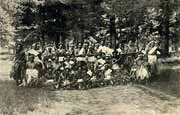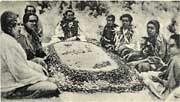|
"Gala dress." Tuck's Post Card. Publisher Raphael Tuck & Sons Ltd., By Appointment. Copyright Fiji Government, Printed in England.No date but probably around 1920. On the reverse is the caption: "These men are prepared for a ceremonial native dance". Specifically, as evidenced by their clubs, a club dance or mekewau. The strip skirts they are wearing are made of the bast of vau (Hibiscus tileaceus). The strips have been pleated by tightly folding, then staining with vegetable dye to give the variegated effect. The two men on the outside are evidently chiefs, wearing tabuluva headbands into which long 'tails' (i-tinisova) of masi barkcloth have been fixed - it is these that mark the men out as chiefs. In addition, the man on the left of the photograph wears the masi wala or barkcloth cummerbund high around his ribs as in warfare. The man on the right of the photo wears a significant length of barkcloth folded on itself and fixed to his waistband. All have their faces blackened for the mock war of the club dance - traditionally with the spores of a fungus (qumu - Polyporus sp.). |
|
|
A meke in Albert Park, Suva (pre-1906) Real photo postcard. Unused, publisher and date unknown. Udivided back so pre-April 1906 when the regulations stipulating this came into effect. Probably betwwen 1896-1906. This does not look like a war-dance, despite the black warpaint (qumu) on the faces of the warriors. It looks more like the sort of performances enacted when the warriors of one ally presented themselves to their allies, such as before a great conflict in which they were to perform together. This was being performed in Suva's Albert Park, but who the warriors were is unknown. It is the case, however, that the elaborately looped white masi barkcloth worn by the warriors is worn in the fashion of Rewa. Particularly splendid is the chief nearest the camera, with his wonderful elaborate hairscarf (i-sala), splendid wasekaseka split-whale-tooth gorget, and large vesa arm-ornaments of masi. |
|
|
"Fijian mekee [meke], Fiji". Handcoloured real photo. Unused, publisher and date unknown. Obviously early, but divided back so post-April 1906 when the regulations stipulating this came into effect. Probably betwwen 1906 and 1908. What is depicted here is a mekenivalu, or war-dance, performed with spears. Note the war-fans held by the dancers, and the low crouching posture that is not seen in this form in today's dances. At the time this photograph was taken, it is a reasonable supposition that at least some of the dancers would have performed such dances before "real" inter-group wars. |
|
|
"'Meke' , Native Dance, Fiji". Unused. Highlights in red added by hand. Published by Gus Arnold, Suva, Fiji. Undated but from the first decade of the 20th Century. The dance shown here is a wesi, with participants brandishing a spear in the right hand and a club in the other. Therefore there are no fans in evidence, since both hands are occupied. The dancer in the centre is brandishing a huge 4-pronged saisai dina. It, and several other spears, are decorated with strips of masi barkcloth. |
|
|
"Fijian Mekemeke, Bau". Unused. Published by Harry Gardiner, Suva, Fiji (S.R.2333). Undated but from the 1920s. Of interest here are the Europeans among the observers in the foreground (and seemingly in the left background). It was obviously an occasion to which they had been invited, and those in the left background, seated, would have been official guests. |
|
|
"Fijian Meke Dance". Published by Caines Studios, Suva, Fiji #104. Unused and undated but from the 1900s. This old photo is of interest from several points of view. The bure is very fine, the dress of the performers is very varied and some of the masi they are wearing is quite unusual, and there are both men and women apparently performing at the same time (though this may simply have been staging on the part of the photographer). And last but not least, it was taken reasonably close-up, so one can actually take in some of these things, unlike most of those above. |
|
|
"Coronation Presentations. The Fijian gift." Unused and undated, but undivided back so pre-1906. No publisher listed, but from the characteristic typescript on the back, it is clearly one of A.M. Brodziak's cards (see Stephenson p.33). These gifts, apparently presented at Government House in Suva, could only have been for the Coronation of King Edward VII in 1902, given the date of the card. |
|
|
"Fijian presents, including Coil of Rope, 7 miles long". Publisher: A.Mills, Suva. Postmarked 1909. Original Collection: W.J. & R.M. Ewins. The 'Cyclopedia of Fiji' states that this photograph is of gifts on the coronation of George V. Actually, it more probably depicts the gifts at the post-funerary rituals related to the death of King Edward VII. This inference may be drawn by the fact that the tall roll of 2-coloured sinnet (magimagi) with a smaller roll of barkcloth (masi) in the top end of it, the whole symbolising a human figure, is a lawa ni mate, used only in the Lau Group ('Windward Islands') as a presentation object, generally at funerary rituals of the highest note. |
|
|
"Feast, Fiji". Unused card #72362, undated but I have seen another card like this postmarked 1905. Photographer/publisher J.W.Waters, Suva, Fiji. Ritual and ceremony are central to Fijian social life. The normal form involves the presentation and consumption of yaqona (kava) and whale-teeth (tabua), and the presentation back and forth of certain sanctioned goods (i-yau) and certain foods which constitute the ritual feast (magiti). Pig, roasted in an earth oven (lovo) is the traditional centrepiece of these food presentations. Here a pig is being prepared for presentation, surrounded by starch vegetables such as taro and yam. Today cattle or goats can be used as well as or instead of pigs, and fish and chickens may be added to the feast. |
|
|
"Material for a feast, Fiji". Photographer and publisher unknown, but number "30" on face. Unused and undated, but probably early 20th Century, and from the men's hairstyles, earlier than the previous photo. The ritual ceremony for which this material was assembled was of moderate size and, with several turtles offered, involved chiefly clans (since the turtle was and still is the exclusive food of chiefs). Turtles remain an important chiefly presentation article, but they are normally presented live, and taken home by the recipients for later consumption. The other food in the two stacks was taro (behind the standing men) and yams. Like the turtles, much of this food would not be for consumption in the feast, but would be presented to the visiting group whom these people were hosting. They would take all this food home and eat it there. In due course they would be invited to visit the other group, and would receive similar gifts in return. |
|
|
"The feast prepared" Unused and undated. Published by Raphael Tuck & Sons, Ltd., London. Copyright Fiji Government. Caption reads: "Almost any occasion is a good reason for a feast in a land where food is so plentiful. These pigs have been roasted whole in a native [earth] oven." In fact, feast of the prodigious size of this one were by no means easy to mount, and would often leave the host village almost destitute following them. The need for competitive generosity demanded the excess. It was perceived as such a problem in early colonial Fiji that the government for a time attempted to ban these huge presentation rituals. |
|
|
"Native feast" Used and dated 11 July 1940. Publisher unknown, but numbered 21. Addressed to Master Bob Waddington, 4380 Holly, Phoenix, Arizona, USA. Another feast of prodigious size, with all of the comments for the previous photo applying here too. The number of beasts (oxen and pigs) in this feast mark it as very costly to those hosting it. |
|
|
"Gifts, meeting of chiefs" Unused and undated. Publisher Stinsons, numbered 1013. Probably 1920s-1930s. An impressive sölevu gift presentation ceremony, probably in Lau to judge by the two fully-rigged outrigger canoes that were part of the presentation. It is difficult to know what the occasion was. The great sölevu presentations that had accompanied the Great Council of Chiefs meetings in the late 19th Century, and nearly bankrupted the hosts, had by the time of this photograph long been banned by the government. It is more likely that the occasion related in some way to the death of a notable chief. |
|
|
"Feast Ceremony, Bau, Fiji". Publisher: Co-Op (Stinson's), Suva, #3B232-N. No date and unused, perhaps 1920s. This was clearly an official occasion, since there were a number of Europeans present in their formal "whites", sola topees etc. Such occasions followed the form of traditional solevu (great meetings), with massive amounts of food and generally gift exchange, as witness the many mats visibel here, in addition to the taro, yams, and whole yaqona (kava) plants. The goods are displayed on the village sward or rärä, in front of the great meeing house (and former heathen temple), Na Vatanitawake. |
|
|
"Native Foods, Taro, Turtles & Yangona Root". Publisher: Caine Studios, Suva, #39. Unused and undated, early 1900s. |
|
|
"Fijian feast at Suva". Publisher: A.M. Brodziak & Co., Suva, Fiji. Undated, but divided-back postcard and therefore post-April 1906, when regulations changed to permit this. This does not mean that the photograph could not have been earlier of course. |
|
|
"Fijians drinking kava". Publisher Caines, Suva 100. Unused. The yaqona (kava) ceremony that is taking place is clearly staged, since the elaborate ritual that is taking place would not normally be performed with only a singe intended recipient. That said, the "form" being used looks authentic. Of more interest is the large bure behind the group, and the standing man, who carries a genuine and good-looking spear of the common bibinicö type. |
|
|
"Presenting Yagona [Yaqona]". Publisher Co-Operative - No. 181. Used but stamp removed and postmark date illegible, but would be no later than 1920;. Addressed to Miss Mattie Malcolm, 19 Corbett Scott Avenue, Epsom., Auck;land S.E.3 Message mostly in shorthand. This very young woman is decked out in a long fibre-strand wäbale sash (compare with man under "People") and is crouching in the appropriate posture for presenting yaqona (kava) to a dignitary. The only problem with this is that even today women very seldom perform this office in the sort of ceremony for which such finery would be appropriate, and in the early 20th Century when this photo was taken, it would never have happened. The woman was chosen for this postcard because she would have been considered more "charming" than the young man who would normally perform this office. |
|
|
"Kava Making Fiji". Unused. Publishers: Morris, Hedstrom & Co., Levuka. Printed Stab. Deutsche Erfindungen - Milano. Probably early 1900s. This group was posed with the group making kava (in Fiji called yaqona) in someone's back yard, as witness the picket fence. That aside, it is reasonably authentic-looking. The man with his hands in the bowl (presumably straining the pounded yaqona root through the bo, or strainer of hibiscus bark fibres) is wearing a recognisable bleached wig that appears in a number of Levuka posed pictures around the turn of the century. |
|
|
"Fijian girls preparing native grog". Unused hand-tinted card. Publishers: Henry Marks & Co. Pre-1920, very possibly pre-1910. A fundamental flaw with this posed group is the premise that has women preparing kava (in Fiji called yaqona). While women today do drink yaqona socially in totally female groups like this, it would have been very uncommon at the time of this picture. And for ritual use, unlike the Polynesian islands to the east, in Fiji it has always been young men who prepare the yaqona. Publishers of the time would have known these things but were also well aware that their customers wanted pictures of young women, so this type of setup was more saleable. This card was released in b&w form by Caine's Studio, Suva (#27) as "Preparing Kava, Fiji" and also as "Making Yangona [Yaqona], Fiji. 31" |
|
|
"Preparing yagona (sic.), Fiji". Unused and undated. Publishers: Co-Operative No.148. The remarks fot he previous picture, about the inappropriateness of showing Fijian women ceremonially preparing yaqona, apply equally to this photo. To exacerbate the error, the woman facing the camera has her eyes blackened with qumu pigment, in the manner of a warrior but not of a young woman. |
|
|
"Kava Ceremony, Fiji". Unused and undated. Publishers: Co-Operative No.3B234-N. The remarks for the previous two pictures apply. |
|
|
"Making kava, Fiji". Publisher Morris, Hedstrom & Co., Levuka. Printed by Deutsche Erfindungen, Milan. Unused and undated, but from the fact that MH's was still headquartered in Levuka, probably late 19th Century. Another picture in which women are performing what is usually a male role in Fiji, preparing yaqona. In this case, however, the women are of distinctly Polynesian appearance and were very probably Samoan - it was a common practice of early Fiji photographers to use Samoan models as their fair looks were considered more 'beautiful' to European eyes. In Samoa female preparation of kava was practised, at least for certain purposes. |
|
|
"Beating Drum, Fiji". Publisher J.W.Waters, Suva, Fiji. #72369, Copyright. Unused, undivided back so pre-1906. The photo shows three men, all apparently chiefs, one of whom is beating a very large gong or lali sitting on the ground. The gong is so large that the man beating it is standing inside it, something that would raise the pitch somewhat. It is typical of the large war-gongs that were so large and valuable that they were stored inside and dragged out onto the rara (village green) for use. For this purpose rope handles were attached to one end. There are none on this example, but there appears to be a square hole on the right top corner, which may have held such a handle at one time. The men are both apparently chiefs because the drummer wears a white i-sala hairscarf though dressed in a post-Christianisation i-sulu vakatoga, as is the man just visible on the left of the photo. The man standing near the drummer is in dance dress (a pandanus strip skirt), but with an i-wabale sash across his torso. Both the scarf and sash are exclusive to chiefs. Incidentally, the second man is holding a piece of wood with a bit of cloth tied around the end, clearly a substitute for a club to be used in a dance. |
|
|
"Beating the Lali (once a Cannibal Drum) to call to Church, Fiji". No publisher, but numbered 24. Not posted, but a message written on the back is dated 24/5/10 [1910]. The photo shows the men, dressed in their Sunday best, beating two Fijian slit-gongs or lali on their coconut-palm supports. Given their attire, they are almost certainly summoning the faithful to church. The arrangement is ideal for complex beats, with a large "main" lali, and a smaller one normally pitched exactly one octave higher. For a discussion of making and use of these gongs, as they are most accurately described, see Rod Ewins 1987. “Lali: the Drums of Fiji”. Domodomo: Fiji Museum Quarterly 4(4):42-169, and Rod Ewins 1999. “The Acoustic Properties of Fijian ‘Slit-gongs’”. Chapter 17, Art and Performance in Oceania, Eds Barry Craig, Bernie Kernot and Christopher Anderson. Bathurst (NSW): Crawford House Press. |
|
|
"Firewalkers". Tuck's Post Card. Publisher Raphael Tuck & Sons Ltd., Art Publishers to Their majesties the King and Queen". Unused. No date, but probably around 1920. On the reverse has the caption: "The firewalkers in the native oven on the island of Bega [Beqa], Fiji. The island is actually called Beqa (pronounced Mbeng-ga - see picture of mountain village) and firewalking is called vilavilairevo. |
|
|
"A Group of Firewalkers". Tuck's Post Card. Publisher Raphael Tuck & Sons Ltd., Art Publishers to Their Majesties the King and Queen".No date, but probably around 1920. Very possibly photographed at the same time and place as the previous one. On the reverse has the caption: "The family of firewalkers prepared for the ceremony - only one family on one island possesses the mysterious secret of walking bare-footed on re hot stones." In fact several villages on the island practice it, not one family.* * [See Rajotte & Bigay (eds) 1981, "Beqa: Island of Firewalkers" Suva: IPS, University of the South Pacific] |
|
|
"Firewalking, Fiji". Publisher and date unknown. Bears caption "16. Firewalking, Fiji." Possibly 1920s, exact location unknown. |
|
|
"Fijian dance amongst bananas". Publisher J.W.Waters, Suva, Fiji. Unused and undated, but undivided back so certainly pre- 1906. This group features Waters's favourite model (far left, wearing a wäloa black warskirt). He and several other men wear white wäbale sashes and i-oro cummerbunds. The man in the centre wears his cummerbund high, in battle a sign of challeng called masi wala. Several of their clubs are kiakavo spur-clubs, probably the commonest club, but the man second from left carries a rootstock club, and the man half hidden by the central figure carries a tötökia beaked battle hammer or pandanus club. |
|
|
"Group of Fijian Fire Walkers at Hagley Park". Publisher Smith & Anthony, Ltd. Unused, date unknown, but early 1900s. This early 20th Century group are described as “Group of Fijian fire walkers at Hagley Park.” This park is in Christchurch, NZ, and it is clear that this travelling troupe did a club dance as part of their performance. All of their clubs are kiakavo spur-clubs. |
|
|
"A Fijian grave". Published by Robbie and Company Ltd., General Merchants, Levuka, Fiji. Printed by Deutsche Erfindungen, Milan. Unused and undated, but Robbie & Co operated in Levuka in the late 19th Century. From the ornate decoration of the frave with black and white stones, capped with sand, this appears to be a Tongan funeral. The mourners have their faces smeared with ash, which gives them the rather ghostly appearance. |
